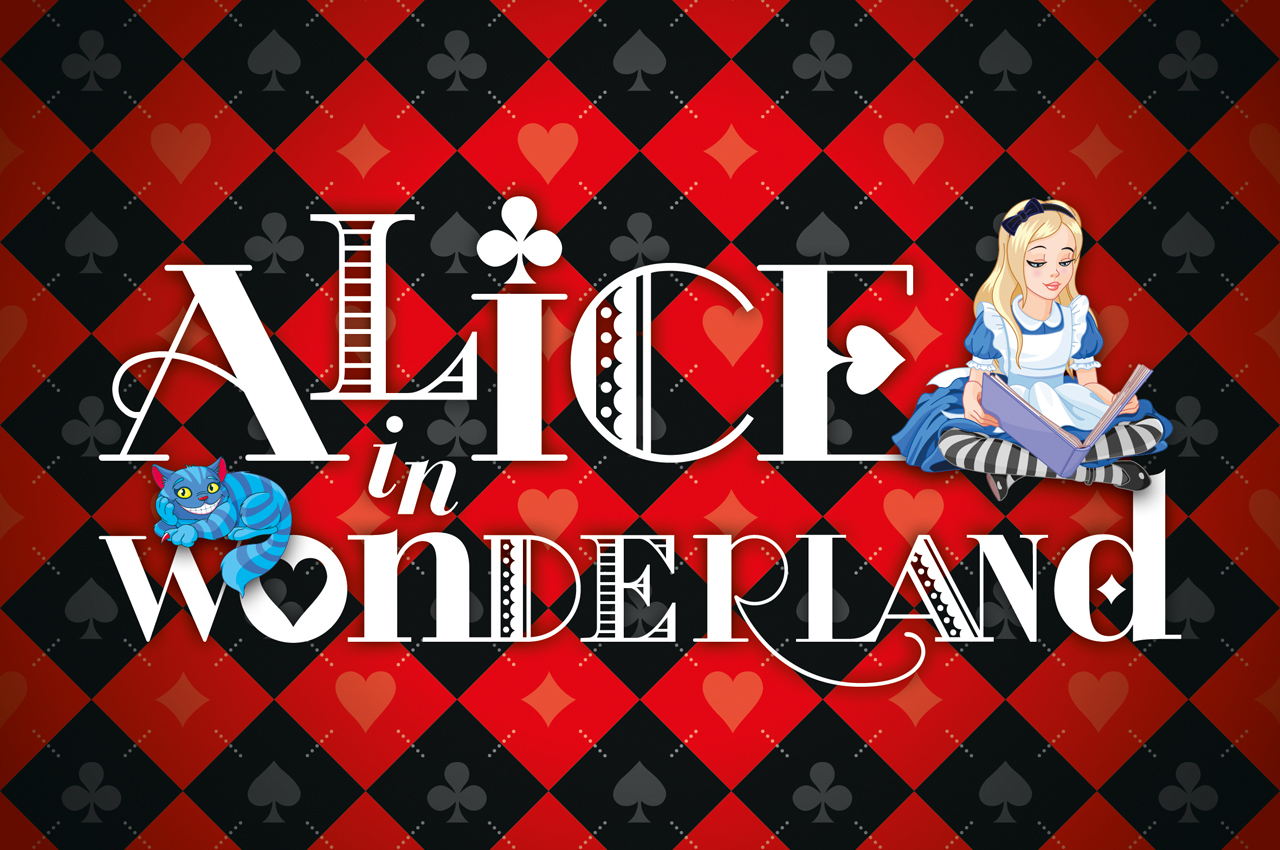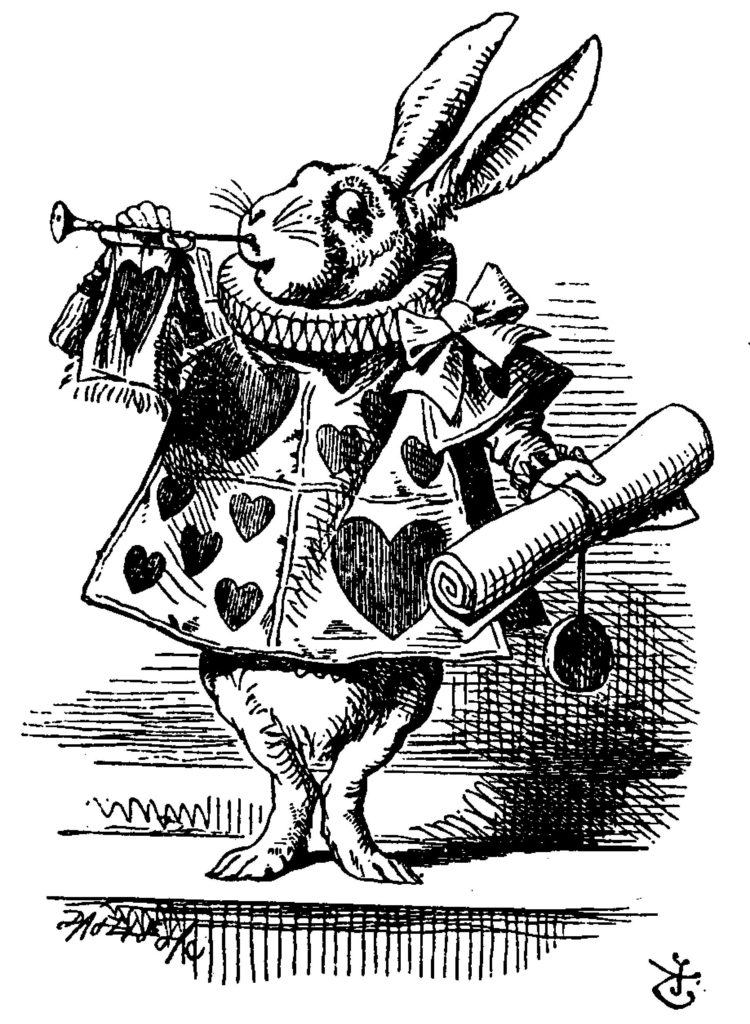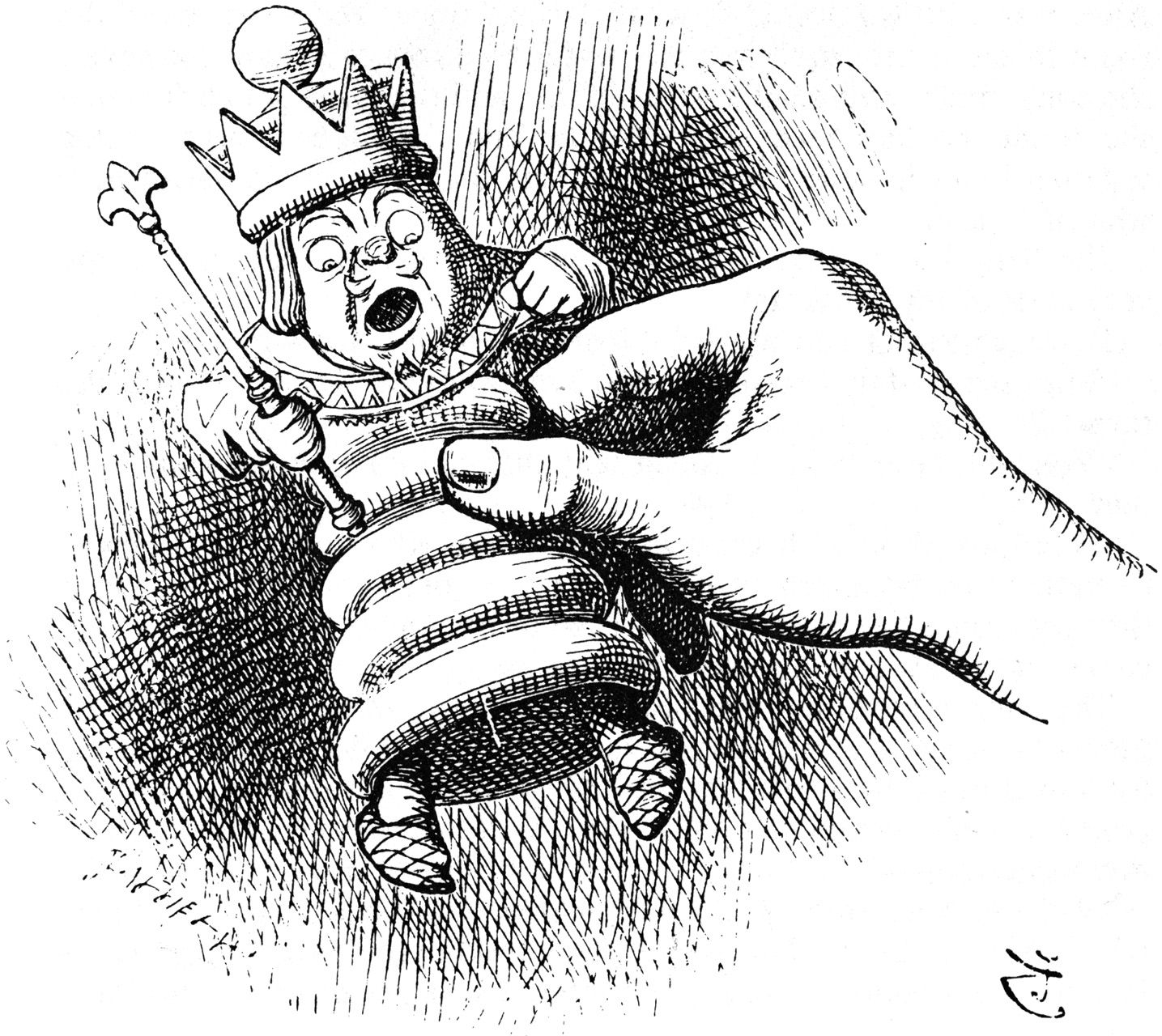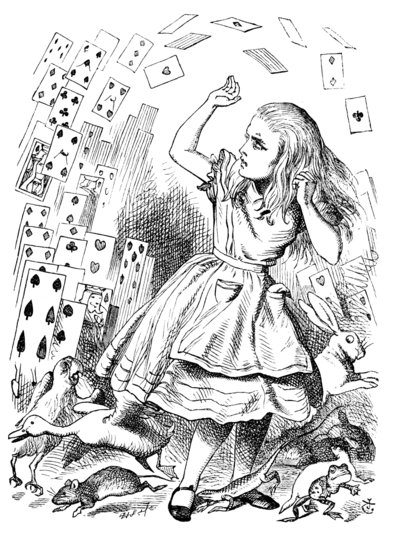
A 2019 Spring Production
Center Stage Production (For ages 6-10 year olds)
Introductory Week Starts January 21st, 2019
General Rehearsals Mondays, Wednesdays, and Fridays 4-6pm
Performs April 19-21, 2019
Tickets
Tickets go on sale April 1st.

Synopsis
Travel down the rabbit hole and join Alice, one of literature’s most beloved heroines, in her madcap adventures. Featuring updated songs from Disney’s thrilling animated motion picture, Disney’s Alice in Wonderland JR. is a fast-paced take on the classic tale.
The ever-curious Alice’s journey begins innocently enough as she chases the White Rabbit. Her adventures become increasingly more strange as she races the Dodo Bird, gets tied up with Tweedle Dee and Tweedle Dum, raps with a bubble-blowing Caterpillar and beats the Queen of Hearts at her own game!
Roles are plentiful, including three Cheshire Cats and dozens of other wonderfully wacky characters, providing plentiful opportunities to showcase students of all different musical skill levels. A chorus of kids playing in the park, rock lobsters, talking fish, royal cards-men, unbirthday partiers, as well as a group of mean-girl flowers, allows for a highly expandable cast size.
Story
On a perfect summer day in the park, Alice sees a White Rabbit hurrying by. Curious to know where he is going, Alice follows him into the dark tunnel, thus beginning her adventure. After the Doorknob counsels Alice to drink from a bottle then eat a cookie, Alice shrinks, thus allowing her to fit through a keyhole, beginning her adventures with the Wonderland creatures. The White Rabbit leads Alice into twin jabbering clowns, Tweedle Dee and Tweedle Dum, who teach her some manners. Then, she plays a wild game of musical chairs at the Mad Hatter's tea party. Following the advice of the Cheshire Cat, she ends up at the Mad Hatter's tea part along with the evil Queen of Hearts. Waking up, Alice realizes the entire story has been a dream!

Tuitions
Ages 6-10 year olds
(attending Mondays, Wednesdays and some Fridays)
$95.00 Audition Fee
$500.00 Tuition
$595.00 Total Fee
* $25.00 discount for paying in full at the time of registration ($570.00)
Final Tuition Payments must be made in one payment within the first two weeks of the program. We do offer some financial assistance to those who need it (see below) and we can offer a payment plan for those who require that as well.
If you have any questions about this please do contact us.
Scholarships
We offer scholarships!
If you require financial assistance please print out the application below. There are no guarantees and all applications must be received by the first day of the program to be considered.
Scholarship / Financial Aid Information
In addition, we offer a deferred payment plan (DPP) for families who cannot pay the lump sump upfront. Please email finance@allabouttheatre.org for more details.

Cast of Characters
- Alice, Small Alice and Tall Alice - differently sized versions of the same character. She is a spunky girl who enjoys adventures and is on a journey of self-discovery. She should be charming to the audience and be able to command the stage by herself. Alice has the largest part in the show so you should cast your strongest singer and actor. Small Alice must also be a good singer and actor while being comfortable as a big part of two dance numbers. And while Tall Alice doesn't have any solos, she needs to be a good actor with solid comic timing. When casting the 3 Alices, keep their height in mind, as that is part of the fun of the show. The more "average" sized your Alice is - the easier it will be find someone smaller and taller. Also it is possible to put Tall Alice on painter's stilts or have your actor sit on someone's shoulder to add height.
- The Cheshire Cat - played by three separate actors who play the head, the body, and the tail of the cat. The Cheshire Cat serves as the Narrator for the story and the actors who are cast need to be able to speak clearly and be good storytellers. Strong singing skills are not a must, but comic timing is, as these three comprise a very funny character. Also make sure to cast a trio who will work well as a team.
- The White Rabbit - an energetic, worrisome character that hardly ever stops moving. Even though the White Rabbit has a solo - the singing should come secondary to finding the person who can exude a lot of energy continuously and create rapid-fire change of focus.
- Tweedle Dum and Tweedle Dee - a pair of goofballs similar to old comedy teams like Abbott & Costello or Laurel & Hardy. They should be good singers and actors who work well as a team. If possible, cast actors who look either exactly alike or completely different for added comic effect.
- Mathilda - Alice's older sister and a non-singing role. She should be a strong actor who can speak loudly and clearly.
- The Flowers (Rose, Petunia, Lily, Violet, Daisy) - the snooty, mean girls who think they are the most important people in the whole world. They need to be good performers and singers who can handle harmonies. There are only five named flowers in the show but it is possible to add as many more as you like.
- Caterpillar, part sensei, part diva, the Caterpillar is comprised of five actors who play the head, body and all those hands, which move in synchronized gestures to help emphasize a point. The Caterpillar is one cool character who needs to be able to sing, dance, and act well. He provides the heart for the story and really convinces Alice to be herself.
- The Mad Hatter is the life of the tea party and should be performed by someone who enjoys acting larger than life. The actor needs to be comfortable being silly and has to sing one song, although it is an easy song to "speak-sing" if necessary.
- The March Hare is the counterpart to the Mad Hatter and also enjoys a good party. A little less crazy than the Mad Hatter, the March Hare is a happy fun character who enjoys playing. The March Hare has solo parts in one song, but a good actor can "speak-sing" them easily.
- The Queen of Hearts is the big, mean, bully of the story. You need a great actor for this role who has a full resonant voice and is able to follow music well. The Queen of Hearts must have a commanding presence and should be a little scary, but funny at the same time.
- The King of Hearts is the often forgotten ruler of Wonderland. You need to have a good actor for this role who can handle some very high-level vocabulary. Casting a small boy in this role will highlight the fact that he is in the shadow of the Queen.
- The Doorknob is a wonderful additional role for a chorus member who is very funny. The character is based somewhat on Jimmy Durante and your actor can have fun playing with that idea.
The Dodo Bird is the Captain of the Queen's Navy and needs to be a good actor and singer. He is in command of the lobsters and other animals and is another of Wonderland's vibrant characters.
- The Chorus (Children Playing in the Park, Rock Lobsters, Talking Fish, Royal Cardsmen, Unbirthday Partiers, etc.) should be comprised of good actors and singers who are featured in all of the production numbers. There are many opportunities for featured moments for many of your ensemble members.
Musical Numbers
- Dodgsonland (Pt. 1) - All
- Dodgsonland (Pt. 2) - Alice, All
- I'm Late! - White Rabbit, Groups, All, Chestire Cat
- Very Good Advice - Alice, Chorus
- Ocean of Tears - Dodo Bird, Rock Lobsters
- The Caucus Race - Dodo Bird, Creatures, Groups, Small Alice, All
- I'm Late! (Reprise) - White Rabbit, Chorus
- How D'ye Do and Shake Hands - Tweedle Dum, Tweedle Dee, Alice, All
- How D'ye Do (Reprise) - Tweedles
- The Golden Afternoon - Flowers
- Zip-A-Dee-Doo-Dah - Caterpillar, All, Small Alice
- Zip-A-Dee-Doo-Dah (Playoff) - All, Groups
- The Unbirthday Song (Pt. 1) - Mad Hatter, Chorus
- The Unbirthday Song (Pt. 2) - March Hare, Chorus, Alice, Mad Hatter, Groups
- I'm Late! (Reprise) - White Rabbit, Chorus
- Painting the Roses Red - Cardsmen, Groups, Alice
- Painting the Roses Red (Reprise) - Queen of Hearts, Cardsmen
- Simon Says (Pt. 1) - Queen of Hearts
- Simon Says (Pt. 2) - Queen of Hearts, Alice
- The Unbirthday Song (Reprise) - Mad Hatter, Queen of Hearts, King of Hearts, All, Groups
- Whooooo Are Youuuuu? - Tweedles, Flowers, Tall Alice, Mad Hatter, Small Alice, White Rabbit, Alice
- EPILOGUE:-
Alice in Wonderland (Finale) - All
Zip-A-Dee-Doo-Dah (Bows) - All, Groups
Discover the story of how Lewis Carroll was inspired to create the world of Wonderland.
The story behind Alice’s Adventures in Wonderland begins with the inventive, playful mind of Charles L. Dodgson (the man behind the pen name Lewis Carroll). A natural storyteller, Dodgson delighted in inventing new stories to entertain his friends. One summer’s afternoon in July 1862 Dodgson rowed up the Thames from Oxford to Godstow with his friend Henry George Liddell and Henry’s eldest daughters, Lorina, Alice and Edith.
It was on this ‘golden afternoon’ that Dodgson first dreamt up the story of Alice and her adventures – inspired by the real little Alice Liddell who asked for a story to keep them amused. The Liddell family loved the tale of Alice’s adventures so much that at the end of the day Alice asked Dodgson to write it down. It would take him two and a half years to complete, but from this afternoon of spontaneous storytelling the Alice in Wonderland we know and love was born.
On 19 October 1863 Dodgson was introduced to the publisher Alexander Macmillan in Oxford by Thomas Combe, director of the Clarendon Press and printer to Oxford University. Macmillan had recently published Charles Kingsley’s children’s novel The Water Babies to much acclaim. Realizing a similar potential in Dodgson’s tale, Macmillan agreed to publish it under Dodgson’s pen name, Lewis Carroll, and on a commission basis: Carroll paid for the printing and marketing, while Macmillan was paid a set commission on sales. This was to be the start of a long and successful publishing relationship between the two of them – Macmillan would go on to publish all of Carroll’s books, as well as many works written under his own name on mathematics, geometry and logic.
After a couple of alternative titles for the story were rejected – Alice Among the Fairies and Alice’s Golden Hour – the book was finally published in 1865 as Alice’s Adventures in Wonderland. The entire print run sold out quickly and Alice’s Adventures in Wonderland became a publishing sensation, adored by children and adults alike.
It was not only Carroll’s wonderful storytelling that captured readers’ imaginations; the illustrations, cleverly incorporated in to the text, brought the story and characters to life and have become part of the book’s cultural phenomenon. They were the work of John Tenniel, a lead cartoonist for the political magazine Punch, whose work Carroll greatly admired. Their collaboration has given us the iconic Alice imagery that remains in our collective consciousness to this day.
To date, Alice’s Adventures in Wonderland has never been out of print and has been translated into at least 176 languages – a story of the timeless joy of pure storytelling, and the mutual passion and vision of author and publisher.
Rehearsal Location
831-345-6340 • info@allabouttheatre.org
